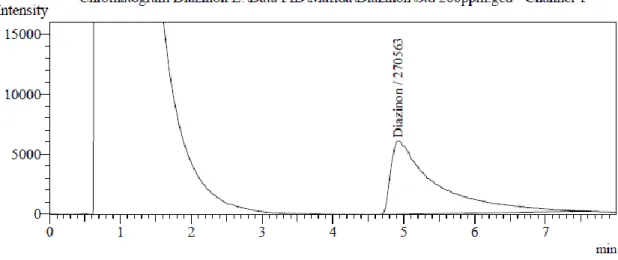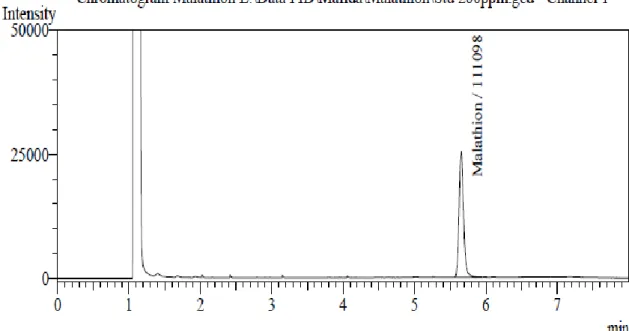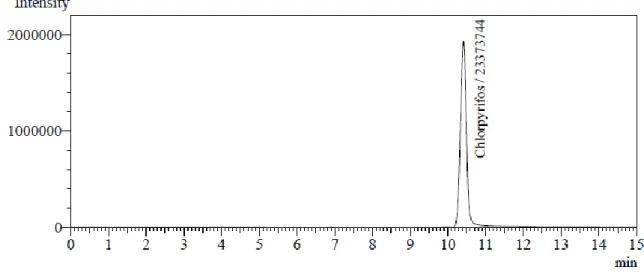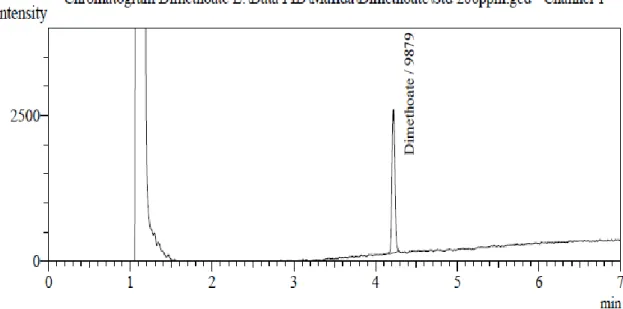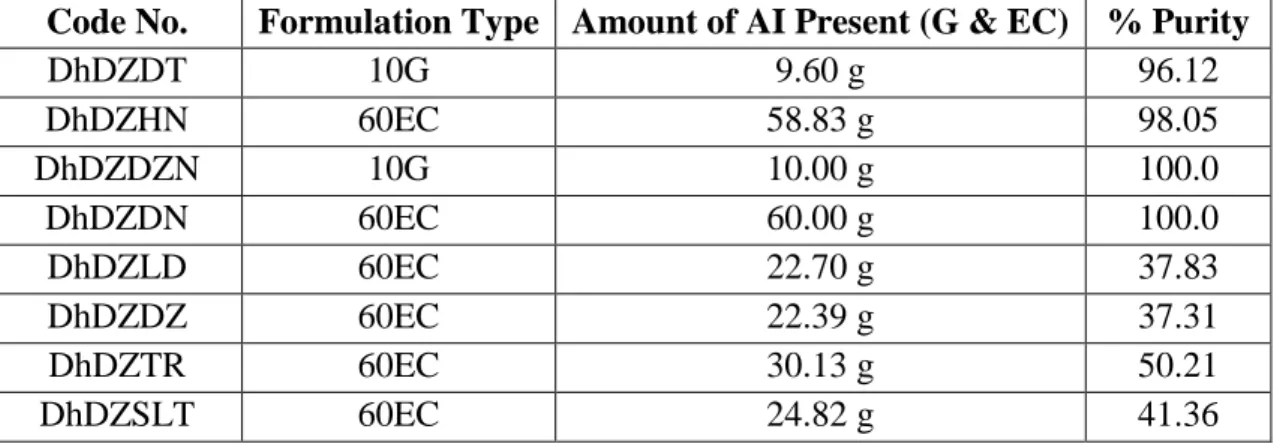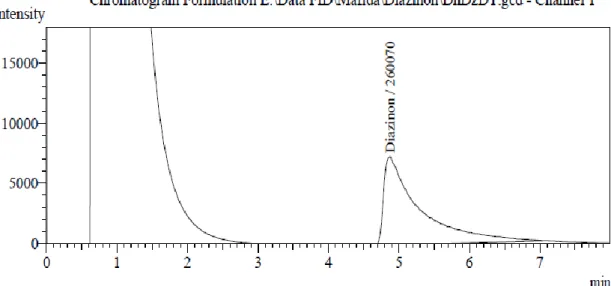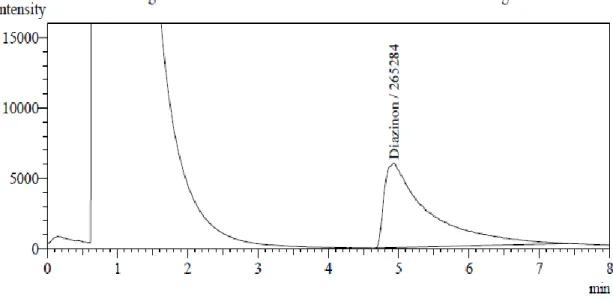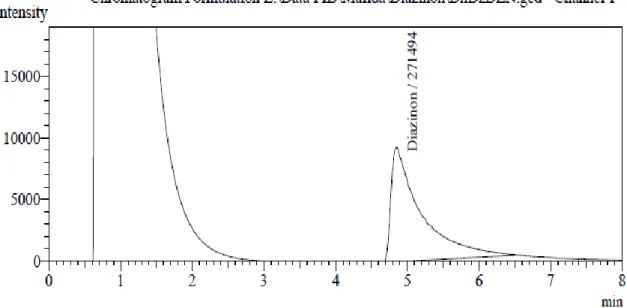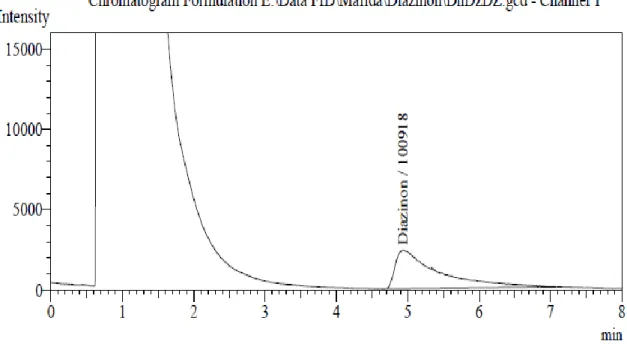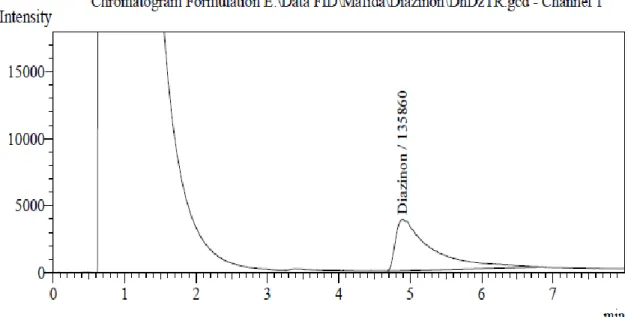i
PURITY ANALYSIS OF SOME MARKETED BRANDS OF
ORGANOPHOSPHORUS PESTICIDES AVAILABLE IN BANGLADESH
MAFIDA AKTER
REGISTRATION NO. 13-05427
DEPARTMENT OF AGRICULTURAL CHEMISTRY SHER-E-BANGLA AGRICULTURAL UNIVERSITY
DHAKA -1207
JUNE, 2020
ii
PURITY ANALYSIS OF SOME MARKETED BRANDS OF
ORGANOPHOSPHORUS PESTICIDES AVAILABLE IN BANGLADESH
BY
MAFIDA AKTER
REGISTRATION NO. : 13-05427
A Thesis
Submitted to the Department of Agricultural Chemistry Sher-e-Bangla Agricultural University, Dhaka
In partial fulfilment of the requirements for the degree of
MASTER OF SCIENCE (MS) IN
AGRICULTURAL CHEMISTRY SEMESTER: JANUARY- JUNE, 2018
Approved by:
Dr. Md. Tazul Islam Chowdhury Professor
Department of Agricultural Chemistry SAU, Dhaka
Supervisor
Dr. Mohammad Dalower Hossain Prodhan Senior Scientific Officer
Pesticide Research & Environmental Toxicology Section, Entomology Division
BARI, Gazipur
Co-Supervisor
Dr. Md. Tazul Islam Chowdhury
Chairman
Department of Agricultural Chemistry
iii
DEPARTMENT OF AGRICULTURAL CHEMISTRY Sher-e-Bangla Agricultural University
Sher-e-Bangla Nagar, Dhaka-1207
CERTIFICATE
This is to certify that the thesis entitled “PURITY ANALYSIS OF SOME MARKETED BRANDS OF ORGANOPHOSPHORUS PESTICIDES AVAILABLE IN BANGLADESH” submitted to the, Faculty of Agriculture, Sher-e-Bangla Agricultural University, Dhaka, in partial fulfillment of the requirements for the degree of MASTERS OF SCIENCE (MS) in AGRICULTURAL CHEMISTRY, embodies the result of a piece of bona fide research work carried out by MAFIDA AKTER, Registration No. 13- 05427 under my supervision and guidance. No part of the thesis has been submitted for any other degree or diploma.
I further certify that such help or source of information, as has been availed of during the course of this investigation has duly been acknowledged.
June, 2020
Dhaka, Bangladesh
(Dr. Md. Tazul Islam Chowdhury) Professor
Department of Agricultural Chemistry SAU, Dhaka
iv
Dedicated to My
Beloved Parents
i
ACKNOWLEDGEMENTS
I seem it a much privilege to express my enormous sense of gratitude to the Almighty Allah for there ever endless blessings for the successful completion of the research work.
I wishe to express my gratitude and best regards to my respected Supervisor, Dr. Md.
Tazul Islam Chowdhury, Professor, Department of Agricultural Chemistry, Sher-e- Bangla Agricultural University, Dhaka, for his continuous direction, constructive criticism, encouragement and valuable suggestions in carrying out the research work and preparation of this thesis.
I express my earnest respect, sincere appreciation and enormous indebtedness to my reverend Co-supervisor, Dr. Mohammad Dalower Hossain Prodhan, Senior scientific officer, Pesticide Research & Environmental Toxicology Section, Entomology Division, Bangladesh Agricultural Research Institute (BARI), Gazipur, Bangladesh, for his scholastic supervision, helpful commentary and unvarying inspiration throughout the research work and preparation of the thesis.
I feel to express my heartfelt thanks again, to the honorable Chairman, Dr. Md. Tazul Islam Chowdhury, Professor, Department of Agricultural Chemistry along with all other teachers and staff members of the Department of Agricultural Chemistry, Sher- e-Bangla Agricultural University, Dhaka, for their co-operation during the period of the study. I am very much greatful to University Grants Commission of Bangladesh for the research fund of this study which was very helpful for me.
I feel proud to express my deepest and endless gratitude to all of my course mates and friends to cooperate and help her during taking data from the field and preparation of the thesis. The author wishes to extend her special thanks to his lab mates, class mates and friends for their keen help as well as heartiest co-operation and encouragement.
I express my heartfelt thanks to my beloved parents, elder sister and brother and all other family members for their prayers, encouragement, constant inspiration and moral support for my higher study. May Almighty bless and protect them all.
The Author
ii
PURITY ANALYSIS OF SOME MARKETED BRANDS OF
ORGANOPHOSPHORUS PESTICIDES AVAILABLE IN BANGLADESH
ABSTRACT
The study was conducted to determine the purity of available marketed brands of five (5) selected organophosphorus pesticides viz., Diazinon, Quinalphos, Malathion, Chlorpyrifos and Dimethoate. A total of forty one (41) samples were collected from different locations of Dhaka district during September’2019 to April 2020. The samples were carried to the Pesticide Analytical Laboratory, Pesticide Research & Environmental Toxicology Section, Entomology Division of Bangladesh Agricultural Research Institute (BARI), Gazipur. The collected samples were analyzed using Gas Chromatography (GC) coupled to Flame Ionization Detector (FID) and Electron Capture Detector (ECD). Among 41 different brands of organophosphorus pesticide samples, 22 (53.65%) were found 100% pure in terms of active ingredient (AI). Whereas 19.51% of the total tested brands were 80-100% pure, and the remaining 26.83% were below 80% pure, of which about 13% pesticide brands contained less than 50% AI. This means that farmers are using pesticides having less amount of AI than required. This study reflects the too much expectation with these 41 samples of the presence of AI in different marketed brands of organophosphorus pesticides in Bangladesh which will help the farmers to be aware of their application for crop protection informed by DAE. It appears that some pesticide groups have more purity compare to others. For example, Chlorpyrifos and Quinalphos grouppesticides.
To ensure 100% AI in different marketed brands of pesticides, regulatory mechanism should be strengthened.
iii
LIST OF CONTENTS
Chapter Title Page
No.
ACKNOWLEDGEMENTS i
ABSTRACT ii
LIST OF CONTENTS iii
LIST OF TABLES iv
LIST OF FIGURES v-vi
LIST OF PLATES vii
ABBREVIATIONS AND ACRONYMS viii
I INTRODUCTION 1-5
II REVIEW OF LITERATURE 6-12
III MATERIALS AND METHODS 13-21
3.1 Study area 13
3.2 Sample collection 13
3.3 Purity Analysis 15
3.3.1 Preparation of standard solution 15
3.3.2 Injection and quantification 15
3.3.3 Apparatus required 17
3.4 Preparation of standard curve 19
IV RESULTS AND DISCUSSION 22-49
4.1 Purity of Some Marketed Brands of Diazinon 22 4.2 Purity of Some Marketed Brands of Quinalphos 27 4.3 Purity of some marketed brands of Malathion 30 4.4 Purity of Some Marketed Brands of Chlorpyrifos 36 4.5 Purity of Some Marketed Brands of Dimethoate 42
V SUMMARY AND CONCLUSION 50-51
REFERENCES 52-65
iv
LIST OF TABLES Table
No. Title Page
No.
1. Sample identification code along with the area of collection of the selected marketed brands of pesticides
14 2. The instrument parameters of GC-2010 set for the analysis of
different organophosphorus pesticides where acetonitrile used as solvent, nitrogen as carier gas, injection volume 1 μl and auto injection method were used
16
3. Percentage of Active Ingredient presents in some marketed
brands of Diazinon 22
4. Percentage of Active Ingredient presents in some marketed brands of Quinalphos
27 5. Percentage of Active Ingredient presents in some marketed
brands of Malathion
31 6. Percentage of Active Ingredient presents in some marketed
brands of Chlorpyrifos
37 7. Percentage of Active Ingredient presents in some marketed
brands of Dimethoate
43 8. Purity comparison of 41 collected pesticide samples 47
v
LIST OF FIGURES
Figure
No. Title Page
No.
1. Standard curve made of different concentrations of Diazinon standard solution
19 2. Standard curve made of different concentrations of Quinalphos
standard
19 3. Standard curve made of different concentrations of Malathion
standard
20 4. Standard curve made of different concentrations of
Chlorpyrifos standard
20 5. Standard curve made of different concentrations of Dimethoate
standard
21 6. Chromatogram of Diazinon found in the sample DhDZDT 23 7. Chromatogram of Diazinon found in the sample DhDZHN 23 8. Chromatogram of Diazinon found in the sample DhDZDZN 24 9. Chromatogram of Diazinon found in the sample DhDZDN 24 10. Chromatogram of Diazinon found in the sample DhDZLD 25 11. Chromatogram of Diazinon found in the sample DhDZDZ 25 12. Chromatogram of Diazinon found in the sample DhDZTR 26 13. Chromatogram of Diazinon found in the sample DhDZSLT 26 14. Chromatogram of Quinalphos found in the sample DhQKL 27 15. Chromatogram of Quinalphos found in the sample DhQCL 28 16. . Chromatogram of Quinalphos found in the sample DhQDG 28 17. Chromatogram of Quinalphos found in the sample DhQAL 29 18. Chromatogram of Quinalphos found in the sample DhQML 29 19. Chromatogram of Quinalphos found in the sample DhQQL 30 20. Chromatogram of Malathion found in the sample DhMaSFN 31 21. Chromatogram of Malathion found in the sample DhMaHFN 32 22. Chromatogram of Malathion found in the sample DhMaFTN 32 23. Chromatogram of Malathion found in the sample DhMaRTN 33 24. Chromatogram of Malathion found in the sample DhMaFFN 33 25. Chromatogram of Malathion found in the sample DhMaMTF 34 26. Chromatogram of Malathion found in the sample DhMaMLT 34 27. Chromatogram of Malathion found in the sample DhMaFCM 35 28. Chromatogram of Malathion found in the sample DhMaRCT 35 29. Chromatogram of Malathion found in the sample DhMaHTN 36 30. Chromatogram of Chlorpyrifos found in the sample DhChPF 37 31. Chromatogram of Chlorpyrifos found in the sample DhChMT 38 32. Chromatogram of Chlorpyrifos found in the sample DhChCB 38 33. Chromatogram of Chlorpyrifos found in the sample DhChDB 39 34. Chromatogram of Chlorpyrifos found in the sample DhChCS 39
vi
35. Chromatogram of Chlorpyrifos found in the sample DhChLT 40 36. Chromatogram of Chlorpyrifos found in the sample DhChSB 40 37. Chromatogram of Chlorpyrifos found in the sample DhChKB 41 38. Chromatogram of Chlorpyrifos found in the sample DhChAC 41 39. Chromatogram of Chlorpyrifos found in the sample DhChAF 42 40. Chromatogram of Dimethoate found in the sample DhDiDT 43 41. Chromatogram of Dimethoate found in the sample DhDiBTT 44 42. Chromatogram of Dimethoate found in the sample DhDiDG 44 43. Chromatogram of Dimethoate found in the sample DhDiDMT 45 44. Chromatogram of Dimethoate found in the sample DhDiTG 45 45. Chromatogram of Dimethoate found in the sample DhDiSG 46 46. Chromatogram of Dimethoate found in the sample DhDiRx 46
vii
LIST OF PLATES
Plate No. Title Page
No.
1. Gas Chromatography 17
2. Electric balance 18
3. Vortex 18
viii
ABBREVIATIONS AND ACRONYMS
ADI ACH APCI ASE
Acceptable Daily Intake Acetylcholine
Atmospheric Pressure Chemical Ionization Accelerated Solvent Extraction
AOAC Association of Official Analytical Chemists BARI
ChE
Bangladesh Agricultural Research Institute Cholinesterase
CSN Committee for Standardization
DAS Days After Spray
DLLME DMCb DMBG DV
Dispersive Liquid–Liquid Micro Extraction Dhaka Market Cabbage
Dhaka Market Bitter Gourd Daily Value
d-SPE dispersive Solid Phase Extraction ECD
EPA ESI
Electron Capture Detector
Environmental Protection Agency Electro Spray Ionization
et al. et alibi (and others)
etc.
ECD
et cetra (and so on)
Electron Capture Detector
EU European Union
FAO FID FPD
FAOSTAT
Food and Agriculture Organization Flame Ionization Detector
Flame Photometric Detector
Food and Agriculture Organization Corporate Statistical Database
FTD GAP
Flame Thermionized Detector Good Agricultural Practices
ix
GCB Graphitized Carbon Black
GC-MS Gas Chromatograph-Mass Spectrometry
HPLC High Performance Liquid Chromatography
HRI KMRL
Hazard Risk Index
Korean Maximum Residue Limits
LC-MS Liquid Chromatography-Mass Spectrometry
LOD Limit of Detection
LOQ MCS
Limit of Quantification
Multiple Chemical Sensitivity Syndrome
MDQ Minimum Detectable Quantity
MRL MRM NPD NPTN NTE PDA
Maximum Residue Limit Multiple Reaction Monitoring Nitrogen-phosphorus Detector
National Pesticides Telecommunications Network Neuropathy Target Esterase
Photodiode Array detection
PDI Potential Daily Intake
PSA PHI
Primary Secondary Amine Pre-Harvest Interval
QuEChERS Quick, Easy, Cheap, Effective, Rugged and Safe
RSM Response Surface Methodology
RTL Retention Time Locked
SAU Sher-e-Bangla Agricultural University SBSE
SE SFE SF SIM SRM SPE
Stir Bar Sorptive Extraction Solvent Extraction
Supercritical fluid extraction Supercritical Fluid
Selected Ion Monitoring Selected Reaction Monitoring Solid Phase Extraction
x TOTAD
TCD
Through Oven Transfer Adsorption Desorption Thermal Conductivity Detector
UHPLC-MS/MS Ultra High Performance Liquid Chromatography- Tandem Mass Spectrometry
WHO World Health Organization
1 CHAPTER I INTRODUCTION
Agriculture plays an important role for the economy of Bangladesh where more than 80% of the people depends on agriculture for their livelihood. Since agricultural land is decreasing, to achieve the targeted food production the major priority has therefore been given on increasing the existing level of productivity of different crops through wider adoption of cost effective technologies with the help of irrigation facility along with use of chemical fertilizers and pesticides (Mukhopadhay, 2005).
Now-a-day the use of pesticides has become indispensable in increasing crop production because of its rapid effect, ease of application and availability (Chowdhury et al., 2011). Pesticide plays an important role for crop production. It is an integral component in agriculture which is used for the better care of field crops and stored grains against unpredictable losses caused by insect pests and diseases. Their use is also aimed at improving both quantity and quality of food and to decrease the loss of vector borne plant diseases.
Thus, pesticides and allied agro-chemicals have become an integral component for sustainable agriculture (Kabir et al., 2008).
Pesticide use in Bangladesh was negligible until 1960. It has been recorded a dramatic increase over the past four decades. This is partly due to government’s priority to adopt chemical control measures to increase crop production as well as to prevent pre and post-harvest crop losses (Aziz, 2005;
Matin, 2003; Rahman et al., 1995). However, a rapid increase in pesticide consumption raises concern about its potential impact on farmers’ health as well as on the environment. Studies on pesticide use in Bangladesh are relatively limited, although news/magazines often report widespread use of banned pesticides including incidences of pesticide poisoning (IRIN, 2010).
2
It was reported that the growth rate of pesticide consumption is likely to increase by the year 2020, especially in the developing countries (Yudelman et al., 1998). Several survey conducted (Kabir et al., 1996; Anonymous, 2001 and Ahmed et al., 2005) at different region of Bangladesh, the farmers spray pesticide every day or in alternate day on vegetables. Insufficient knowledge and non-availability of sustainable alternatives to pesticide farmers of Bangladesh become dependent on pesticide for crop production. Unjustified and excessive use of pesticide may cause severe harmful effect on human health, environmental pollution and destruction of agricultural ecosystem and emergence of resistance in insect pest, pathogens and weeds (Handa and Walia, 1996).
Farmers of Bangladesh generally use many types of pesticides to control harmful pests to minimize the crop loss without considering other factors. They use pesticides indiscriminately but the indiscriminate use of pesticides against the pest cause several problems. These harmful pesticides are dissolved in our water system and ultimately enter into the system of human, fishes and many other animals and cause severe damage to their health (Khandakar, 1990;
Mansingh, et al,.1996; Price, 2008; Chowdhury et al., 2013).
It has been reported that the growth rate of pesticide consumption is likely to increase by the year 2020, especially in the developing countries (Yudelman et al., 1998). Several survey conducted (Kabir et al., 1996; Anonymous, 2001 and Ahmed et al., 2005) at different region of Bangladesh, the farmers spray pesticide every day or in alternate day on vegetables. Insufficient knowledge and non-availability of sustainable alternatives to pesticide farmers of Bangladesh become dependent on pesticide for crop production. Unjustified and excessive use of pesticide may cause severe harmful effect on human health, environmental pollution and destruction of agricultural ecosystem and emergence of resistance in insect pest, pathogens and weeds (Handa and Walia, 1996).
3
Among other groups of pesticides, Organophosphorus pesticides (OPPs) are organic ester derivatives of phosphorous, generally thiol or amide derivatives of thiophosphoric, phosphinic, phosphonic, phosphoric acids with additional side chains of phenoxy, cyanide and thiocyanate group (Kumar et al., 2016).
Organophosphate compounds are the main components of herbicides, pesticides, and insecticides.
The worldwide consumption of OPPs rose to an amount of 5 million and reached 6.8 million from 2011 to 2015 (Wang et al., 2015). They are widely used all over the world because they possess ability to rapidly degrade under natural conditions sunlight, air, and soil (Dhas and Srivastava, 2010). OPs are mostly water soluble and disseminates easily into the environment via dis- solution, abrasion and volatilization (Balderacchi et al., 2013).
Acute or chronic exposure to OPPs can produce varying levels of toxicity in humans, animals, plants, and insects. Most of the organophosphate pesticides inhibit acetylcholinesterase activity which affects the nervous system in both aquatic and terrestrial fauna (Muhammad, 2017; King and Aaron, 2015).
Pesticide consumption in Bangladesh has increased day by day as 758 metric tons in 1960 and 3028 metric tons in 1980 to over 19000 metric tons in 2000 (Hasanuzzoha, 2004). The growth rate analysis of pesticide consumption in a period of 24 years shows an average of 9.0% annual increase (Ali, 2004). In the year 2007, over 37,712.20 tons of pesticides were being sold in Bangladesh (Anonymous, 2007). It might also be due to impurity and adulteration of the used insecticides. It is reported that less amount of active ingredient in the formulated pesticides, they do not work against insect pests and the farmers use more pesticide for better result (Kabir et al., 2008).
In Bangladesh there is widespread evidence that pesticides are used inappropriately. In one survey of 820 farmers carried out in several districts in Bangladesh, 70% of the pesticides used were classed as ―extremely or very
4
hazardous‖ and 47% of farmers were found to be overusing them. In the same survey, only 4% of farmers reported receiving basic training on the safe handling of pesticides, and 87% admitted that they did not use any protective measures when mixing and handling pesticides (Prodhan et al., 2018).
Pesticide is a main factor in control agricultural and food pests and to pest vector control, especially in epidemics. However, impure pesticides do not reach their goal and at the same time they may be phytotoxic to treated crops and harmful to humans and the environment. Thus, it is clear the need for good-quality pesticide products and in this regard, specifications are crucial in improving pesticides quality. In relation with impurities appearing in pesticides, they are usually formed from starting materials or side-reactions within the synthesis and also during final product storage. Excessive and non- judicious use of pesticide has raised several environmental and social issues, as well as, destruction of agricultural ecosystem and development of resistance in insect pest, pathogens and weeds (Begum et al., 2016).
In the country report originated by FAO (2011) Corporate Document Repository, it has been reported that the regulatory scheme for pesticide registration is systematic. But in practice, it has a gap between policies and implementation. While the intent of the ordinance and rules to monitor formulations and residue is commendable, the lack of facilities and trained analysts does not allow proper monitoring. Thus, specification of pesticides on the market may differ from those registered (Aziz, 2006).
Therefore, it is assumed that impurity of pesticide is one of the major causes of extensive use of pesticide in Bangladesh. Sub standard or little amount of active ingredient (AI) in the formulated pesticides, does not work against insect pests and diseases and the farmers use more pesticide for better result. Impurity and adulteration may be one of the reasons of over and repeated use of pesticides in crops as well as decline in efficacy of applied insecticides
5
(Anonymous, 2009). Keeping this view, the present study has been conducted with the following objectives:
1. To assess the active ingredients of some selected marketed brands of organophosphorus pesticides.
2. To evaluate the purity of some marketed brands of organophosphorus pesticides for their purity determination
6
CHAPTER II
REVIEW OF LITERATURE
It is assumed that impurity or adulteration of pesticide might be one of the major causes of extensive use of pesticide in Bangladesh. Impure pesticides may less or no effective for the control of insect pest and diseases. In this perspective, it has become important to analyze the marketed brands of insecticides for the determination of percent purity and to find out the actual amount of active ingredient remain in the marketed brands. With this respect some review of literature is presented below:
2.1 Toxicity of organophosphate pesticides
Organophosphate pesticides have been shown to adversely affect the photo- synthesis (Zobiole et al., 2012; Kielak et al., 2011) plant mineral nutrition (Zobiole et al., 2010; Zobiole et al., 2011), carbon metabolism (Ding et al., 2011; Zobiole et al., 2011), photochemical reactions (Vivancos et al., 2011), chlorophyl biosynthesis (Serra et al., 2013), fatty acids synthesis, amino acids synthesis, nitrogen metabolism (Zobiole et al., 2010), and oxidative stress (Vagi et al., 2018; Stauber et al., 2016; Filimonova et al., 2016; Yanniccari et al., 2012).
Organophosphorus prevents the biosynthesis of catalase, perioxidase and 5- aminolevulinic acids (ALA) which are the major component of chlorophyl biosynthetic pathway by inducing Fe deficiency in plants (Barcelos et al., 2012). However, it affects ALA production by competing with the major product of the ALA synthetase active site or leading to deprivation of glumate content by competing with glycine in the photorespiration process as depicted in soybean (Vivancos et al., 2011). They also reduce the availability of amino acids and metal ions which are associated with PSI and PSII to transfer photon (light energy) into the electron transport chain system (Cakmak et al., 2009).
7
Foliar spray of glyphosate and its metabolites decreases the net stomatal conductance and carbon exchange in plants thus reducing the CO2 assimilation capacity (Zobiole et al., 2011; Ding et al., 2011). Exposure of organophosphate pesticide, glyphosate also lower down the levels of 3- phosphoglyceric acid (PGA) and ribulose-1,5-biphosphate (RuBP) affecting ribulose 1,5-biphosphate carboxylase oxygenase activity (Rubisco) in plants (De-Maria et al., 2006).
The reduction of plant growth due to OPs could also be possibly due to effect on cell division and elongation. Mishra et al. (2015) reported delayed seedling emergence and reduced lumber of Vigna radiata upon treatment with phorate.
Various concentrations of chlorpyriphos in the range from 0 to 1.5 mM were spiked on twenty-day old plants of V. radiata through foliar spray. Analyses was done at pre-flowering stage (Day 5), flowering stage (Day 10) and post flowering stage (day 20) after the treatment. Chloropyrifos was found to reduce plant growth and nitrogen metabolism in V. radiata.
Excessive use of organophosphate pesticides affects the non-target crops and non-target animal species found in various aquatic and terrestrial ecosystems (Blann et al., 2009).
The interactions of the pesticides with soil organic inorganic component at the molecular level are central to their bioavailability, bioaccumulation, transport and toxicity in the environment (Morton and Edwards, 2005).
Profound understanding of the soil’s interactions with pesticides is crucial to understand the soil-pesticide-minerals, soil-pesticide- organic matter, soil- pesticide-plant and soil fertility mechanisms (Polubesova and Chefetz, 2014).
OPs are known to interact on soil’s mineral surface and organic matter present in soil (Dror et al., 2017; Alfonso et al., 2017; Scheunert, 2018).
The interaction of pesticides to soil depend upon four main factors; nature of solute (pesticide), solvent (mainly water), soil constituents and pH (Gianfreda and Rao, 2008). In general, mineral surface is positively charged at low pH and
8
negatively charged at high pH values. As a result, positively charged metal ions interact to mineral surface at moderate acidic to basic pH. The negative charged ligands interact to soil’s minerals surfaces at low pH only.
2.2 Methods of Detection of Organophosphorus Pesticides
The advent of different analytical techniques has enabled us to infer the information and determine the structure of the newly synthesized molecule.
Presently, continuous investigation is being conducted to uncover the ligand and reporting media for OPs detection via various spectroscopic techniques like UV-Vis (Yuan et al., 2015); FTIR (Du et al., 2010); mass spectrometry (Lorenzo and Pico, 2017); X-ray diffraction (Gong et al., 2012);
electrochemical and NMR Spectroscopy (Hiscock et al., 2015; Kumar et al., 2013).
The detection and estimation of organophosphate pesticides has been reported in water (Borjesson and Torstensson, 2000), guava fruit extract, soil (Peruzzo et al., 2008), sediments (Aparicio et al., 2013), animal and human tissues (Kruger et al., 2014), plants tissues (Nedelkoska and Low, 2004), wheat grains (Jan et al., 2009), urine samples, organs of dairy cow (Kruger et al., 2014), soybean extracts (Arregui et al., 2004) and carrot (Kataoka et al., 1996).
2.3 Gas Chromatography
A gas chromatograph (GC) is an analytical instrument that measures the content of various components in a sample. There are many detectors which can be used in gas chromatography. Different detectors will give different types of selectivity. Flame ionization Detector (FID) is feasible for most of the organic compounds. Usually FID are used for the purity analysis of pesticides.
Thermal conductivity Detector (TCD) is a universal detector. Electron capture Detector (ECD) detector is used for halides, nitrates, nitriles, peroxides, anhydrides, organometallics etc. Nitrogen-phosphorus Detector (NPD) detector is normally used for Nitrogen, phosphorus and the Flame photometric Detector
9
(FPD) detector are used for sulphur, phosphorus, tin, boron, arsenic, germanium, selenium and chromium. Till today, GC technique with different detectors are used for the quantification of pesticide residues from different food matrices (Prodhan et al., 2010; Prodhan et al., 2009; Panhwar and Sheikh, 2013; Latif et al. 2011; Bemph et al., 2011; Srivastava et al., 2011; Chandra et al., 2010; Kabir et al., 2007; Hajslovaet al., 1998).
2.3 Purity analysis of pesticides
Organophosphates are one of the major constituent of herbicides, pesticides, insecticides and nerve gas. Azinophosmethyl, chlorpyrifos, diazinon, fonofos and disulfoton are wellknown organophosphate pesticides (OPs) having extensive applications in agriculture, horticulture, pest control, plastic making, flame retardants and for several household applications (Sidhu et al., 2019).
Some reviews are presented on purity analysis of some selected pesticides which were collected from different sources which are as follows:
Begum et al. (2016) carried out a study to determine the purity of available marketed brands of nine selected pesticides viz., chlorpyrifos, diazinon, carbofuran, pyrazosulfuranethyle, dimethoate, cypermethrin, carbendazim, mencozeb and quinalphos. These pesticides were collected from local markets of eight locations viz., Rajshahi, Rangpur, Dinajpur, Bogra, Chittagong, Mymensing, Comilla, Norshingdi and Jessoredistricts of Bangladesh where extensive use of pesticides was recorded. Among the 66 tested pesticides, 44 (66.66 %) were found 90% pure in terms of active ingredient (AI). The purity range of about 12% of the total tested brands was 80%--90% and the remaining 21.34% were less than 80 % pure, of which three pesticide brands contained no active ingredient (AI) at all.
Ahmed et al. (2016) made a study on testing purity of different marketed brands of three insecticide groups such as quinalphos, malathion and fenitrotion in the Pesticide Analytical Laboratory under Division of Entomology, Bangladesh Agricultural Research Institute (BARI), Gazipur
10
using suitable protocols GC-FID. Nineteen marketed brands of these insecticides collected form dealers or retailers of Jessore, Gazipur and Rangpur region were analyzed and estimated their purity in two seasons of 2006-2007 and 2007-2008. In these two seasons, among five marketed brands of Malathion, only one brand (MTF) had 98.95-100% purity which was collected from Jessore in 2007-08 and Gazipur in both the seasons and considered to be standard or acceptable product, but in other regions, this brand contained less AI and was found to be <95% pure which was considered as substandard product. The remaining brands contained 22-92% purity including SRL and MTX having small amount of AI (22-44% purity) and all these were unacceptable and impure. Fenitrothion with five marketed brands showed . 96% purity only in SMT brand in Gazipur and Jessore in 2006-07 and in all the three locations in 2007-08 seasons and this brand considered as standard product. The other four brands of this insecticide had purity at substandard level in all locations in two seasons. Quinalphos with 8 marketed brands, only MLX in 2006-07 and BLX in 2007-08 seasons in all locations had . 95 % purity which was standard product. ALX and CRX in 2006-07 were almost similar and close to MLX except one location, CRX in Gazipur and ALX in Jessore but these two brands were substandard and impure (65-86%) in next season in all locations. The other brands (KNX, QNP, VNR and SLX) were also substandard and impure having 59% to 87% purity.
Ahmed et al. (2017) carried out this study to quantify the purity of different marketed brands of three insecticide namely diazinon, acephate and cypermethrin using suitable protocols GC-FID and GC-ECD. Nineteen marketed brands of these insecticides collected from retailers of Jessore, Gazipur and Rangpur region were analyzed and estimated their purity in two seasons of 2006-2007 and 2007-2008. Among six marketed brands of diazinon, only one brand (RSN) had 96.71-100% purity in both the seasons in all locations which considered to be standard product, but four brands (DZN, SBN, HZN, DNN) in other regions, contained <95% pure which were
11
substandard product. The remaining 2 brands (DNN, AZN) contained 33.71- 51.94% purity in 2006-07 and the other two brands (SBN, DZN) had very small amount of active ingredient (0.16-0.84% purity) in 2007-08 and all these were impure in quality. All five tested brands of acephate had 57.14-88.59%
purity in 2006-07 which were substandard but in 2007-08, three brands (SNT, BNS, ATF) showed >90% purity and the remaining 2 had <80% purity which were less AI than required. Of eight tested brands of cypermethrin, three brands were almost to have >95% pure in 2006-07 in all locations. The other two brands (CPR, AMT) contained >90% purity. In 2007-08, two brands of cypermethrin (RCD, SCR) contained >95% pure, another two brand (CRN, RLT) had 88.77-91.15% purity. The brands UTD was standard in purity in 2006-07 but this brand was below standard in quality in 2007-08 in all locations. Most of the tested brands of cypermethrin were found standard and sub standard level of purity in comparison to diazinon and acephate.
Islam et al. (2016) conducted a study to analyze the purity of nine commercially available brands of carbofuran which were collected from different locations of Gazipur, Bangladesh and their purity were determined by HPLC method using HPLC 20A Promience. Carbofuran (2,3-dihydro-2,2- dimethylbenzofuran-7-yl methylcarbamate) is a systematic insecticide which is used to control a wide variety of field crops. A standard calibration curve was obtained from the plot of different concentrations (ppm) vs. area of standard carbofuran solution using GCMS QP-2010, Shimadzu Corporation, Japan.
Among the examined nine brands, four displayed 100% purity, three showed over 80% purity, and two had below 70% purity with respect to standard carbofuran. The results of this study would be helpful for dealers, consumers, and farmers to know the available carbofuran percentage in different brands in Bangladesh.
Marina et al. (2019) carried out a study to find out the actual scenario of the available marketed brands of eleven selected pesticides collected from local
12
markets of seven different locations of Bangladesh. In this study, Gas Chromatography coupled with Flame Ionization Detector (FID) and Electron Captured Detector (ECD) was used to determine the purity of acephate, diazinon, dimethoate, chloropyrifos, quinalphos, malathion, cypermethrin, fenvelarate and fenitrothion and High Performance Liquid Chromatography (HPLC 20A Prominence) coupled with Photo Diode Array (PDA) detector was also used to determine the purity of carbofuran and carbosulfan. They were collected and analyzed 95 different pesticide brands. Among the tested brands, 57 brands contained 100% AI, while 31 tested brands of different pesticides contained 80-99% AI and 7 tested brands of different pesticides contained below 80% AI.
Marina et al. (2020) carried out a study to find out the actual scenario of the available marketed brands of eleven selected pesticides collected from local markets of seven different locations of Bangladesh. In this study, Gas Chromatography coupled with Flame Ionization Detector (FID) and Electron Captured Detector (ECD) was used to determine the purity of acephate, diazinon, dimethoate, chloropyrifos, quinalphos, malathion, cypermethrin, fenvelarate and fenitrothion and High Performance Liquid Chromatography (HPLC 20A Prominence) coupled with Photo Diode Array (PDA) detector was also used to determine the purity of carbofuran and carbosulfan. Results indicated that 40% of tested pesticides have lower Active Ingredient (AI) than stated on the label of container. A total of 69 brands were tested. Out of 69 tested brands, 44 were found 100% pure in terms of AI presence, 16 tested brands contained <100% but ≥ 90% AI, 8 tested brands had < 90% but ≥ 80%
AI and remaining 1 brands contained below 80% AI.
13
CHAPTER III
MATERIALS AND METHODS
The samples of different marketed brands of organophosphorus pesticides were collected from different markets of Dhaka district. A total of forty one (41) samples were collected. The collected samples were carried to the Pesticide Analytical Laboratory, Pesticide Research & Environmental Toxicology Section, Entomology Division, Bangladesh Agricultural Research Institute (BARI), Joydebpur, Gazipur for pesticide purity analysis during September 2019 to April 2020. From sampling to final analysis, required procedures are described below.
3.1 Study area
The study area is Dhaka district, which is the capital of Bangladesh which is under total area of 306.40 square kilometers with 6 Upazilas. In this study, different marketed brands of organophosphorus pesticides were collected from different market of Dhaka district
3.2 Sample collection
A total of forty one (41) samples were collected for this study. Sample was collected in individual polyethylene bag and tagged with clear levels for identification. Different marketed brands of organophosphorus pesticides namely, Diazinon, Quinalphos, Malathion, Chlorpyrifos and Dimethoate were purchased. The sample identification code along with the area of collection of the selected marketed brands of pesticides are presented in Table 1.
14
Table 1. Sample identification code along with the area of collection of the selected marketed brands of pesticides.
Name of Pesticides Sample ID Area of collection
Diazinon
DhDZDT DhDZHN DhDZDZN DhDZDN DhDZLD DhDZDZ DhDZTR DhDZSLT
Samples of DhDZDT, DhDZHN and DhDZDZN were collected from Jurain, Dhaka. Samples of DhDZDN and DhDZLD were collected from Nawabpur, Dhaka and samples of DhDZDZ, DhDZTR and DhDZSLT were collected from Savar, Dhaka.
Quinalphos
DhQKL DhQCL DhQDG DhQAL DhQML DhQQL
The samples; DhQKL and DhQCL were collected from Dhamrai, Dhaka. The samples; DhQDG, DhQAL and DhQML were collected from Amin Bazar, Dhaka and the sample; DhQQL was collected from Nawabpur, Dhaka.
Malathion
DhMaSFN DhMaHFN DhMaFTN DhMaRTN DhMaFFN DhMaMTF DhMaMLT DhMaFCM DhMaRCT DhMaHTN
The samples; DhMaSFN, DhMaHFN, DhMaFTN and DhMaRTN were collected from Middle Badda, Dhaka.
The samples; DhMaFFN, DhMaMTF, DhMaMLT and DhMaFCM were collected from Jurain, Dhaka. The samples; DhMaRCT and DhMaHTN were collected from Savar, Dhaka.
Chlorpyrifos
DhChPF DhChMT DhChCB DhChDB DhChCS DhChLT DhChSB DhChKB DhChAC DhChAF
The samples; DhChPF and DhChMT were collected from Dhamrai, Dhaka.
The samples; DhChCB, DhChDB, DhChCS, DhChLT and DhChSB were collected from Savar, Dhaka. The samples; DhChKB, DhChAC and DhChAF were collected from Amin Bazar, Dhaka.
Dimethoate
DhDiDT DhDiBTT DhDiDG DhDiDMT DhDiTG DhDiSG DhDiRX
The samples; DhDiDT and DhDiBTT were collected from Nawabpur, Dhaka.
The samples; DhDiDG, DhDiDMT and DhDiTG were collected from Middle Badda, Dhaka. The samples; DhDiSG and DhDiRX were collected from Jurain, Dhaka.
15 3.3 Purity Analysis
The experiment was done at Pesticide Analytical Laboratory, Pesticide Research and Environmental Toxicology Section (PRETS), Entomology Division, BARI, Joydebpur, Gazipur. In this experiment, 41 brands of 5 Organophophorus pesticides were tested. These brands of Organophophorus pesticides were collected from different locations of Dhaka district, Bangladesh. The standard of Organophophorus pesticides were obtained from Sigma Aldrich Laborchemikalien, GMbh, P. O. Box No.- 100262, D-30918 seelze, Germany via Bangladesh scientific Pvt. ltd. Dhaka, Bangladesh. The percent purity of this standard was above 99.6%
3.3.1 Preparation of standard solution
Standard of selected pesticides was dissolved in methanol and prepared to100 ppm solution following the standard procedure. Similarly, all brands were dissolved in methanol targeting to prepare 100 ppm solutions (weight by volume). The solid inert materials were removed by filtration and the color was removed by GPC (Gel- Performance Chromatography). The solvent was selected on the basis of the criteria described by Lehotay and Mastovska (2004).
3.3.2 Injection and quantification
The solutions of different brands of marketed pesticides were prepared in the pesticide analytical laboratory following the procedure compatible with the respective equipment. In case of granular pesticides the solid inert materials were removed by filtration. In case of liquid pesticides, the known concentration of the solutions was prepared directly. Methods for testing different brands with GC-FID, and GC-ECD were developed by setting the instrument parameters suitable for analyzing concerned pesticides selected on the basis of peak sharpness of the chromatogram and retention time for respective compound. The instrument parameters for GC-FID, and GC-ECD set for analysis of each group of pesticide are listed below in Table 2.
16
Table 2. The instrument parameters of GC-2010 set for the analysis of different organophosphorus pesticides where acetonitrile used as solvent, nitrogen as carier gas, injection volume 1 μl and auto injection method were used
Pesticides Detector Temperature Injection volume
Dimethoate
FID
Column-190°C, Injection port-220°C, Detector- 250°C
1 μl
Malathion
Column-160°C (1min)- 270°C (10°C/min) (6min), Injection port- 280°C, Detector-300°C
1 μl
Quinalphos
Column-160°C (1min)- 270°C (10°C/min) (6min), Injection port- 280°C, Detector-300°C
1 μl
Diazinon
Column-160°C (1min)- 270°C (10°C/min) (6min), Injection port- 280°C, Detector-300°C
1 μl
Chlorpyrifos
ECD Column-160°C (1min)- 270°C (10°C/min) (6min), Injection port- 280°C, Detector-300°C
1 μl
17
All injection was made by automated computer operated injector. After the injection, data were acquired and processed by the built in software of GC. The amount of active material present in each brand comparing with standard solution of pesticide sample was calculated with the help of the built in software of GC
The calculation was done by using the following formula:
Percent of Purity = Actual amount of AI present in pesticide × 100 Amount of AI required
3.3.3 Apparatus required
1. GC-2010, Shimadzu corporation, Japan
2. Electric balance, Model: AY-220, Shimadzu Corporation, Japan (Plate 2).
3. Vortex, Model: Maxi max ii, USA (Plate 3).
Plate 1: Gas Chromatography (GC-2010)
18
Plate 2: Electric balance (AY-230) Plate 3: Vortex (Maxi max II)
In addition to the above instruments the following accessories were also used:
(a) Scissors
(b) Measuring cylinder (c) Conical flask (d) Volumetric flask (e) Tray
(f) Knife (g) Spatula (h) Funnel (i) Test tube (j) Micro pipette (k) Aluminum foil (l) Para film (m) Glass vial
(n) HPLC filter paper etc.
19 3.4 Preparation of standard curve
Prior to the injection of the sample, standard solutions of each pesticide were prepared and injected with suitable instrument parameters. The samples were calibrated (retention time, peak area etc.) against standard curve of standard solution of concerned pesticide (Figure 1-5). Each peak was characterized by its retention time. Sample results were expressed in ppm automatically by the GC software.
Figure. 1. Standard curve made of different concentrations of Diazinon standard solution
Figure 2. Standard curve made of different concentrations of Quinalphos standard
20
Figure 3. Standard curve made of different concentrations of Malathion standard
Figure 4. Standard curve made of different concentrations of Chlorpyrifos standard
21
Figure 5. Standard curve made of different concentrations of Dimethoate standard
22
CHAPTER IV Results and Discussion
Forty one (41) marketed brands of different organophosphorus pesticides were collected from different markets of Dhaka district, Bangladesh to determine the purity of pesticides. The results obtained from this study are presented and described in this chapter using figures and tables.
4.1 Purity of Some Marketed Brands of Diazinon
In the present study some marketed brands of Diazinon were collected from different locations of Dhaka for the determination of purity. Eight popular brands of Diazinon were tested with the help of HPLC 20A prominence using PDA detector. Percent of Diazinon present in the formulated products along with their purity percentage are shown in the Table 3. From Table 3, it is observed that the purity of tested brands ranged from 37.31%-100%.
Table 3: Percentage of Active Ingredient presents in some marketed brands of Diazinon
Code No. Formulation Type Amount of AI Present (G & EC) % Purity
DhDZDT 10G 9.60 g 96.12
DhDZHN 60EC 58.83 g 98.05
DhDZDZN 10G 10.00 g 100.0
DhDZDN 60EC 60.00 g 100.0
DhDZLD 60EC 22.70 g 37.83
DhDZDZ 60EC 22.39 g 37.31
DhDZTR 60EC 30.13 g 50.21
DhDZSLT 60EC 24.82 g 41.36
Results showed that only two samples (DhDZDZN and DhDZDN) were 100%
pure followed by the sample DhDZDT (purity = 96.12%) and DhDZHN (purity
= 98.05%) and rest of the samples were impure as it was recommended in its label. The lowest active ingredient was found from the sample of DhDZDZ
23
(22.39) which was 37.31% pure whereas the samples DhDZLD (purity = 37.83%) and DhDZTR (purity = 50.21%) showed lower purity.
Figure 6-13 shows the chromatograms of the injected extracts of Diazinon pesticide samples containing detected purity.
Figure 6. Chromatogram of Diazinon found in the sample DhDZDT
Figure 7. Chromatogram of Diazinon found in the sample DhDZHN
24
Figure 8. Chromatogram of Diazinon found in the sample DhDZDZN
Figure 9. Chromatogram of Diazinon found in the sample DhDZDN
25
Figure 10. Chromatogram of Diazinon found in the sample DhDZLD
Figure 11. Chromatogram of Diazinon found in the sample DhDZDZ
26
Figure 12. Chromatogram of Diazinon found in the sample DhDZTR
Figure 13. Chromatogram of Diazinon found in the sample DhDZSLT
27
4.2 Purity of Some Marketed Brands of Quinalphos
In this study some marketed brands of Quinalphos were collected from different locations of Dhaka for the determination of purity. Six popular brands of Quinalphos were tested with the help of HPLC 20A prominence using PDA detector. The percent Quinalphos present in the formulated products along with their purity percentage are shown in the Table 4. It was observed that the purity of tested brands ranged from 99.92%-100% i.e. almost all the branded samples collected on Quinalphos products were 100% pure (Table 4).
Table 4: Percentage of Active Ingredient presents in some marketed brands of Quinalphos
Code No. Formulation Type Amount of AI Present (EC) % Purity
DhQKL 25EC 25.00 g 100.0
DhQCL 25EC 25.00 g 100.0
DhQDG 25EC 25.00 g 100.0
DhQAL 25EC 25.00 g 100.0
DhQML 25EC 25.00 g 100.0
DhQQL 25EC 25.00 g 99.92
Figure 14-19 shows the chromatograms of the injected extracts of Quinalphos pesticide samples containing detected purity.
Figure 14. Chromatogram of Quinalphos found in the sample DhQKL
28
Figure 15. Chromatogram of Quinalphos found in the sample DhQCL
Figure 16. Chromatogram of Quinalphos found in the sample DhQDG
29
Figure 17. Chromatogram of Quinalphos found in the sample DhQAL
Figure 18. Chromatogram of Quinalphos found in the sample DhQML
30
Figure 19. Chromatogram of Quinalphos found in the sample DhQQL
4.3 Purity of some marketed brands of Malathion
In the present study some marketed brands of Malathion pesticides were collected from different locations of Dhaka for the determination of purity. Ten popular brands of Malathion were tested with the help of HPLC 20A prominence using PDA detector. The percent Malathion present in the formulated products along with their purity percentage are shown in the Table 5. From Table 5, it is observed that the purity of tested brands ranged from 20.25% - 100%. Results also showed that only two samples (DhMaSFN and DhMaMTF) were 100% pure followed by the sample DhMaFFN (purity = 97.09%) and DhMaMLT (purity = 95.73%) and rest of the samples was impure as it was recommended in its label. The lowest active ingredient was found from the sample of DhMaRTN (11.54) which was 20.25% pure whereas the samples; DhMaFTN (purity = 55.78%), DhMaFCM (purity = 60.04%), DhMaRCT (purity = 66.11%) and DhMaHTN (purity = 50.21%) showed lower purity.
31
Table 5: Percentage of Active Ingredient presents in some marketed brands of Malathion
Code No. Formulation Type Amount of AI Present (EC) % Purity
DhMaSFN 57EC 57.00 g 100.00
DhMaHFN 57EC 50.41 g 88.44
DhMaFTN 57EC 31.79 g 55.78
DhMaRTN 57EC 11.54 g 20.25
DhMaFFN 57EC 55.34 g 97.09
DhMaMTF 57EC 57.00 g 100.00
DhMaMLT 57EC 54.57 g 95.73
DhMaFCM 57EC 34.22 g 60.04
DhMaRCT 57EC 37.68 g 66.11
DhMaHTN 57EC 28.62 g 50.21
Figure 20-29 shows the chromatograms of the injected extracts of Malathion pesticide samples containing detected purity.
Figure 20. Chromatogram of Malathion found in the sample DhMaSFN
32
Figure 21. Chromatogram of Malathion found in the sample DhMaHFN
Figure 22. Chromatogram of Malathion found in the sample DhMaFTN
33
Figure 23. Chromatogram of Malathion found in the sample DhMaRTN
Figure 24. Chromatogram of Malathion found in the sample DhMaFFN
34
Figure 25. Chromatogram of Malathion found in the sample DhMaMTF
Figure 26. Chromatogram of Malathion found in the sample DhMaMLT
35
Figure 27. Chromatogram of Malathion found in the sample DhMaFCM
Figure 28. Chromatogram of Malathion found in the sample DhMaRCT
36
Figure 29. Chromatogram of Malathion found in the sample DhMaHTN
4.4 Purity of Some Marketed Brands of Chlorpyrifos
In the present study some marketed brands of Chlorpyrifos were collected from different locations of Dhaka for the determination of purity. Ten popular brands of Chlorpyrifos were tested with the help of HPLC 20A prominence using PDA detector. The percent of Chlorpyrifos in the formulated products along with their purity percentage are shown in the Table 6. In table 6, it is observed that the purity of tested brands ranged from 92.06%-100%. Results showed that most of the samples of Chlorpyrifos products which were collected from different market places was pure except two samples (DhChCB) and (DhChSB) and these two samples were also above 90% pure.
37
Table 6: Percentage of Active Ingredient presents in some marketed brands of Chlorpyrifos
Code No.
Formulation Type
Amount of AI Present (EC&WP)
% Purity
DhChPF 20EC 20.00 g 100.00
DhChMT 48EC 48.00 g 100.00
DhChCB 20EC 19.67 g 98.37
DhChDB 20EC 20.00 g 100.00
DhChCS 20EC 20.00 g 100.00
DhChLT 20EC 20.00 g 100.00
DhChSB 20EC 18.41 g 92.06
DhChKB 50WP 50.00 g 100.00
DhChAC 20EC 20.00 g 100.00
DhChAF 48EC 48.00 g 100.00
Figure 30-39 shows the chromatograms of the injected extracts of Chlorpyrifos pesticide samples containing detected purity.
Figure 30. Chromatogram of Chlorpyrifos found in the sample DhChPF
38
Figure 31. Chromatogram of Chlorpyrifos found in the sample DhChMT
Figure 32. Chromatogram of Chlorpyrifos found in the sample DhChCB
39
Figure 33. Chromatogram of Chlorpyrifos found in the sample DhChDB
Figure 34. Chromatogram of Chlorpyrifos found in the sample DhChCS
40
Figure 35. Chromatogram of Chlorpyrifos found in the sample DhChLT
Figure 36. Chromatogram of Chlorpyrifos found in the sample DhChSB
41
Figure 37. Chromatogram of Chlorpyrifos found in the sample DhChKB
Figure 38. Chromatogram of Chlorpyrifos found in the sample DhChAC
42
Figure 39. Chromatogram of Chlorpyrifos found in the sample DhChAF
4.5 Purity of Some Marketed Brands of Dimethoate
Some marketed brands of Dimethoate were collected from different locations of Dhaka for the determination of purity. Seven popular brands of Dimethoate were tested with the help of HPLC 20A prominence using PDA detector.
Percent of Dimethoate present in the formulated products along with their purity percentage are shown in the Table 7. Purity of tested brands ranged from 47.38%-100% were observed in table 7. Results showed that three samples (DhDiBTT, DhDiDG and DhDiTG) were 100% pure followed by the sample DhDiSG (purity = 92.74%) and rest of the samples was impure as it was recommended in its label. The lowest active ingredient was found from the sample of DhDiDT (18.95) which was 47.38% pure whereas the samples;
DhDiDMT (purity = 54.87%) and DhDiRx (purity = 55.99%) gave lower purity.
43
Table 7: Percentage of Active Ingredient presents in some marketed brands of Dimethoate
Code No. Formulation Type Amount of AI Present (EC) % Purity
DhDiDT 40 EC 18.95 g 47.38
DhDiBTT 40EC 40.00 g 100.00
DhDiDG 40EC 40.00 g 100.00
DhDiDMT 40EC 21.95 g 54.87
DhDiTG 40EC 40.00 g 100.00
DhDiSG 40EC 37.09 g 92.74
DhDiRx 40EC 22.39 g 55.99
Figure 40-46 shows the chromatograms of the injected extracts of Dimethoate pesticide samples containing detected purity.
Figure 40. Chromatogram of Dimethoate found in the sample DhDiDT
44
Figure 41. Chromatogram of Dimethoate found in the sample DhDiBTT
Figure 42. Chromatogram of Dimethoate found in the sample DhDiDG
45
Figure 43. Chromatogram of Dimethoate found in the sample DhDiDMT
Figure 44. Chromatogram of Dimethoate found in the sample DhDiTG
46
Figure 45. Chromatogram of Dimethoate found in the sample DhDiSG
Figure 46. Chromatogram of Dimethoate found in the sample DhDiRx
47
From the above results it can be mentioned that a considerable amount of marketed brand pesticides are not 100% pure. Regarding collection of Diazinon samples, only 25% were 100% pure whereas 25% were 90-100% pure and highest 50% were 30-50% pure. Similarly, in terms of collected Quinalphos samples, all most all were 100% pure. But in terms of collected Malathion samples, only 20% were 100% pure whereas 30% were 80-100% pure and highest 50% were 20-70% pure. Again, in case of collected Chlorpyrifos samples, most of the samples (80%) were 100% pure whereas only 20% were 90-100% pure. But in terms of collected Dimethoate samples, 42.86% were 100% pure whereas only 14.29% were 90-100% pure and 28.57% were 40- 60% pure. As a result among all 41 collected pesticides samples, only 53.66%
were 100% pure whereas 19.51% were 80-100% pure and 26.83% were 26- 70% pure. Similar result was also observed by Begum et al. (2016) who carried an experiment with 66 tested pesticides, among them 66.66% (44 in numbers) were found 90% pure in terms of active ingredient (AI). The purity range of about 12% of the total tested brands was 80%-90% and the remaining 21.34%
were less than 80% pure, of which three pesticide brands contained no active ingredient (AI) at all. Similar results also observed by Ahmed et al. (2016, 2017) and Islam et al. (2016).
Table 8. Purity comparison of 41 collected pesticide samples Pesticide
Name
Collected No.
˃90%
pure
80-90%
pure
˂80%
pure
˂50%
pure
Comments
Diazinon 8 4 - 1 3
Quinalphos 6 6 - - - All are pure
Malathion 10 4 1 4 1
Chlorpyrifos 10 10 - - - All are pure
Dimethoate 7 4 - 2 1
48
In table 8, it was observed that Quinalphos and Chlorpyrifos were mostly pure among other group of pesticides whereas Diazinon was most adulterated pesticides where 50% of the collected samples purity was below 80% of AI.
And among 41 samples, 68% (28 in number) were found ˃90% pure in terms of active ingredient (AI). The purity range of about 17% of the total tested brands was ˂80% and the 12% were less than 50 % pure.
These results were very similar to Begum et al. (2016). They analyzed 66 samples from eight different locations of Bangladesh. Among the 66 tested pesticide samples, 66.66 % (44 in number) were found ˃90% pure in terms of active ingredient (AI). The purity range of about 12% of the total tested brands was 80%--90%. And the remaining 21.34% were less than 80 % pure, of which three pesticide brands contained no active ingredient (AI) at all.
From this study it also revealed that although Diazinon is banned but upto now it is used due to its rapid action and ease of cost. Due to broad range of actions, Diazinon (organophosphorus pesticide) is used to control pest insects in soil, on ornamental plants, and on fruit and vegetable field crops. It was formerly used as the active ingredient in household and garden products used to control pests such as flies, fleas, and cockroaches.
The farmers of our country are using pesticides indiscriminately for the control of insect pests and diseases and to increase the production. There are many reasons behind this overuse use of pesticides. Pesticide adulteration is one of the major reasons for the excessive and indiscriminate use of pesticides. Due to the adulteration, the activity of pesticides is reduced and that is why, the farmers are spraying pesticides very often to control the insect-pests and diseases. As a result of frequent application of pesticides, their residues are remaining of different agricultural commodities reported by several researchers of Bangladesh (Nahar et al., 2020; Islam et al., 2019; Islam et al., 2019a;
Islam et al., 2019b; Rahman et al., 2019; Prodhan et al., 2018; Prodhan et al., 2018a; Prodhan et al., 2018b; Hasan et al., 2017; Aktar et. al., 2017; Islam et.
49
al., 2014; Hossain et al., 2014; Prodhan et al., 2010; Prodhan et al.2009; Kabir et. al., 2008a; Kabir et. al., 2007), the insect-pests are developing resistance and due to the excessive use of pesticide insect pollinator also declined day by day (Amin et al., 2014). Besides, a lot of money also spends for buying pesticides. On the other hand, extensive use of pesticides disrupts the agro eco- system and also creates many adverse effects on human health and the environment.
50
CHAPTER V
SUMMARY AND CONCLUSION
Cereal, pulse, oils and vegetables growers of Bangladesh use pesticides more frequently than usual for the control of insect pests and diseases and to get higher yield. Improper application along with impurity of marketed insecticides is suspected for control failure and repeated use of insecticides. Frequent use of insecticides is likely to cause residual problem which pose environmental pollution and contaminate our food chain.
The purity of pesticides and residue analysis are a great concern to ensure safe food. However, a very limited research work has been conducted in this area due to the limited number of pesticide analytical laboratory in Bangladesh. In recent years, pesticide analytical and residue research gained momentum in Bangladesh. Pesticide Analytical Laboratory (Accredited as per ISO/IEC 17025:2017) of BARI attained ability of detecting 0.5-1.0 ppb concentration of several pesticides which makes MRL (Maximum Residue Limit) and ADI (Acceptable Daily Intake) research feasible in Bangladesh.
Results indicated that among the collected samples of Diazinon, only 25%
showed 100% pure whereas 25% were 90-100% pure and 50% shoed less than 60% purity. All the collected Quinalphos samples showed 100% purity. In terms of collected Malathion samples, only 20% showed 100% purity whereas 30% gave 80-100% purity and 50% showed below 20-70% purity. Regarding the collected Chlorpyrifos samples, 80% showed 100% purity and 20% gave above 90% purity. In case of collected Dimethoate samples, 42.86% showed 100% purity whereas 14.29% showed above 90% purity and 28.57% gave below 60% purity.
Though insecticide becomes an important component for steady crop production but proper research planning, rules and regulations are lacking which could play as a proper guideline for the whole nation. The results of the
51
present study clearly indicated that among 41 different brands of organophosphorus pesticides, only 53.66% were 100% pure whereas 19.51%
were 80-100% pure and 26.83% were below 80% pure. This means that farmers are using pesticides having less amount of AI than required thus the expected results cannot be attained and the cost of production is getting increased.
To prevent the selling of less pure insecticides regular monitoring is needed which could be achieved through strengthening of pesticide analytical research.
Pesticide analytical lab should be established across the country which could provide quick service to the farmers. Besides, regulatory mechanism should be strengthened to punish the guilty party.
